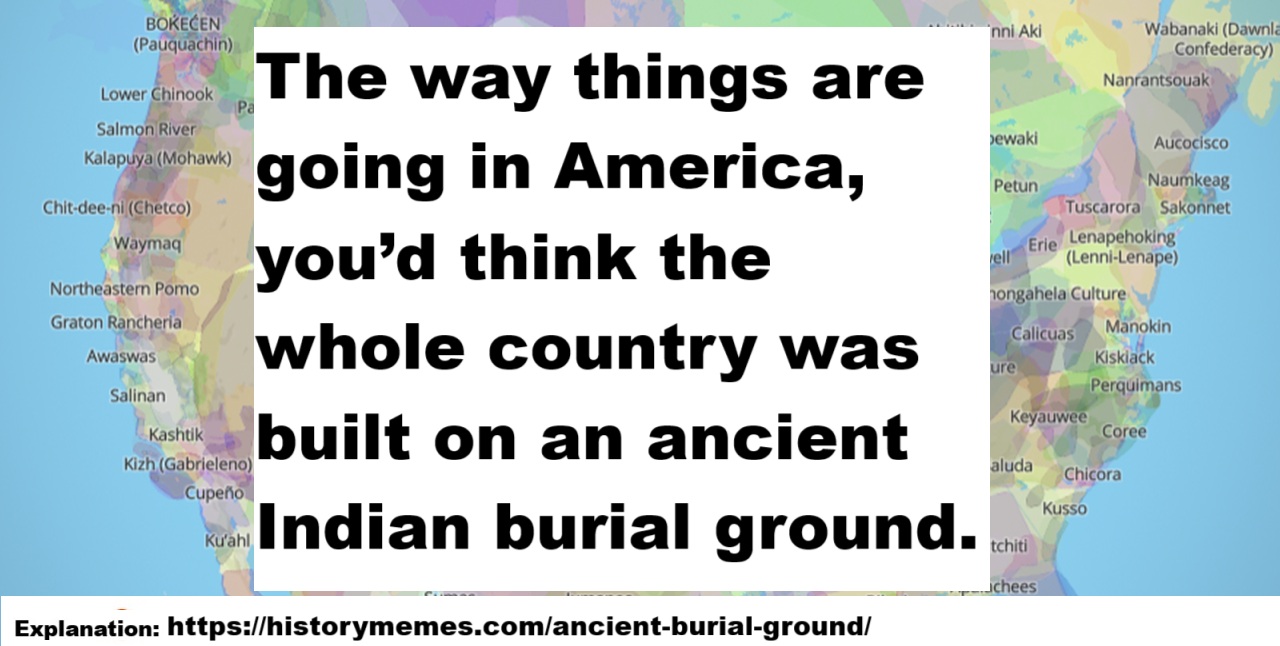
The full text from the meme above reads: The way things are going in America, you’d think the whole country was built on an ancient Indian burial ground.
Here’s what it means:
That meme is making a dark joke about America’s problems by comparing them to a familiar horror movie trope.
The reference:
- In horror films, houses or towns built on ancient burial grounds are often portrayed as cursed, bringing bad luck, hauntings, or disasters.
- It’s a shorthand way of saying: “No wonder everything’s going wrong, the place is doomed from the start.”
The meme’s point:
- It jokes that the United States’ ongoing streak of crises, chaos, or misfortune isn’t just coincidence.
- Instead, it’s as if the whole country were literally cursed, like those horror-movie houses.
- The “ancient Indian burial ground” phrase also references how the U.S. was built on land taken from Native peoples, often through violence and displacement, so the “curse” is also a metaphor for historical injustices haunting the present.
The “built on an ancient burial ground” meme connects to a very real history of how the United States expanded across the continent.
Here’s an expanded view, step by step:
Early Colonization & Dispossession
- European colonists (Spanish, French, English, Dutch, etc.) arrived in the 1500s–1600s.
- They took Native lands through a mix of military conquest, forced treaties, and settlement pressure.
- Colonists often justified it with ideas like the “Doctrine of Discovery” (a legal-religious concept that Christian nations could claim non-Christian lands).
Formation of the U.S. & Expansion Pressure
- After independence in 1776, the U.S. wanted to grow westward.
- The federal government signed treaties with Native nations but rarely honored them, using them as temporary measures until settlers demanded more land.
- Native people were often promised protection or payment that never came.
Indian Removal & Forced Relocation
- The Indian Removal Act of 1830 authorized the government to force Native nations east of the Mississippi to move west.
- This led to the Trail of Tears (1830s), where Cherokee, Choctaw, Chickasaw, Creek, and Seminole people were marched hundreds of miles, thousands died.
- The idea was to clear the Southeast for white settlement and agriculture.
Military Campaigns & Reservations
- Through the 1800s, the U.S. Army fought many Indian Wars against Native nations resisting invasion.
- Famous examples: the Sioux Wars, the Nez Perce War, the Apache resistance under Geronimo.
- Defeated tribes were forced onto reservations, often on marginal land far from their homelands.
Broken Treaties & Allotment
- The U.S. signed hundreds of treaties with Native nations, but broke most of them.
- The Dawes Act (1887) divided tribal lands into individual allotments to push assimilation. “Surplus” land was sold to settlers, leading to the loss of about 90 million acres of Native land.
Cultural Suppression
- Beyond land, the U.S. government tried to erase Native cultures.
- Children were forced into boarding schools (“Kill the Indian, save the man”), where they were punished for speaking their languages or practicing traditions.
- Religious ceremonies were banned until the late 20th century.
Legacy
- By 1900, Native peoples had lost the overwhelming majority of their lands.
- The U.S. literally built its towns, farms, and industries on land taken from Indigenous nations.
- The “burial ground” line isn’t just metaphorical, in many places, settlers displaced or massacred Native communities, and development happened directly over sacred sites.
So, when people say “America’s cursed like it was built on a burial ground,” they’re half-joking but also pointing to how the U.S. was founded on violent displacement that still echoes today (poverty, legal battles over land, cultural survival).
Books on the subject:
- Atlas of Indian Nations
- In the Hands of the Great Spirit: The 20,000-Year History of American Indians
- The History of the American Indians
- National Geographic The Indian Wars: Battles, Bloodshed, and the Fight for Freedom on the American Frontier
What do you think?
Leave a Reply